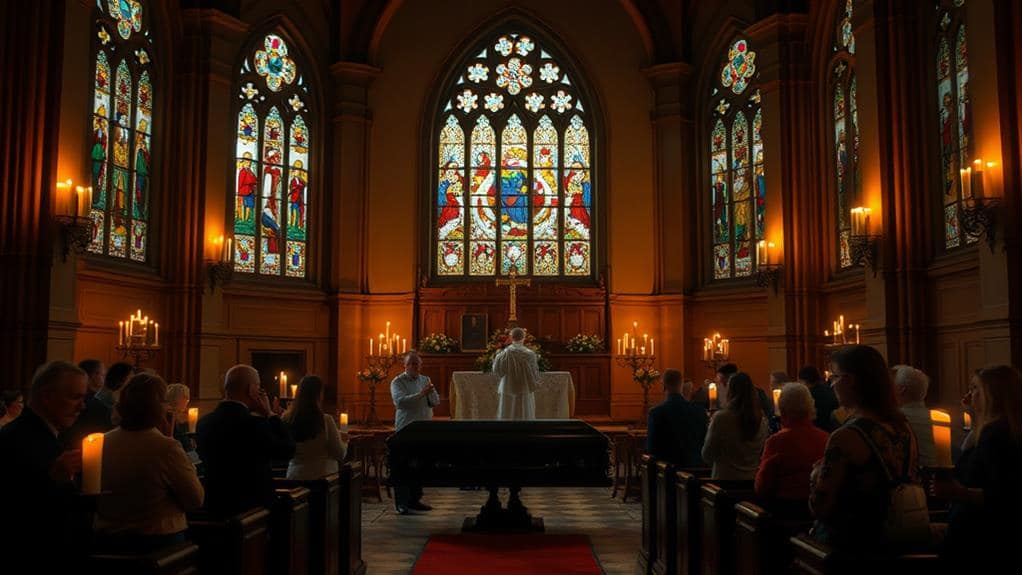In the colorful world of biblical symbolism, it turns out that Jesus has quite the wardrobe! Who knew the Savior of the world was such a trendsetter?
Colors like gold, blue, and purple not only beautify the narrative but also reveal Jesus' divine essence. Gold shines with purity and righteousness, blue connects us to the heavenly realm, and purple proudly displays his royal status as the Messiah.
As we unravel these vibrant hues, we enrich our understanding of Jesus' character and deepen our connection to God. By exploring the biblical meanings behind these colors, we catch a glimpse of God's love and righteousness.
So, let's dive into this colorful journey and uncover the divine color mystery that makes our spirituality shine!
Key Takeaways
- Jesus' association with divine colors like purple, gold, and blue highlights his divinity, purity, and heavenly connection.
- Gold symbolizes Jesus' righteousness and eternal value, while purple represents his divine kingship and status as the Messiah.
- Blue signifies Jesus' connection to God's presence and heavenly realm, emphasizing his divine nature.
- The use of colors in biblical narratives and artistic depictions conveys spiritual significance and deepens understanding of Jesus' character.
- Understanding the divine color palette enhances comprehension of Jesus' divinity, God's love, and the sacrifice of Christ.
Colors in Biblical Symbolism
In the rich fabric of biblical narratives, colors play an essential role in conveying spiritual concepts, emotions, and cultural symbols.
We see that colors served as a powerful form of communication in ancient times, acting as a divine language that enhanced beliefs and spirituality. Each hue conveyed distinct meanings and messages, reflecting the cultural and spiritual landscape of the era.
Understanding the color significance in biblical contexts is fundamental for grasping spiritual interpretation. Gold represents divinity, purity, and righteousness, while blue signifies heavenly connection and God's presence. Purple denotes royalty and nobility, and red symbolizes sacrifice and sin.
Jesus' Association With Divine Colors
As we explore the rich fabric of biblical colors, our focus shifts to Jesus' association with divine colors, which profoundly reveals His character and mission.
We see Jesus' royal representation in the color purple, symbolizing His divine kingship and status as the Messiah.
In artistic representations, Jesus is often depicted in gold, reflecting His divine attributes of purity, righteousness, and eternal value.
The use of blue in biblical narratives highlights Jesus' heavenly connection and God's presence, underscoring His role as the divine Son.
By examining Jesus' association with these divine colors, we gain a deeper understanding of His character and mission, as well as the spiritual significance of His life and teachings.
This color symbolism enriches our comprehension of Jesus' divine nature.
Biblical Colors and Their Meanings
Through the lens of scripture, we find that biblical colors convey rich spiritual meanings that deepen our understanding of God's nature and character.
As we investigate these colors, we discover that they evoke powerful spiritual emotions, from the gold of divinity and purity to the blue of heavenly connection and God's presence. Each hue carries distinct cultural meanings, reflecting the ancient context in which they were used.
For instance, purple denotes royalty and nobility, while red symbolizes sacrifice and sin. White, on the other hand, represents purity and cleansing power.
Interpreting Colors in Scripture
Numerous biblical accounts illustrate the significance of colors in scripture, demonstrating their role in conveying spiritual truths and themes.
As we explore the world of biblical colors, we recognize that color perception plays an essential role in understanding their spiritual significance. Each hue conveys distinct meanings and messages, reflecting the cultural and spiritual landscape of the era.
By examining the biblical narratives, we find that colors like gold, blue, and purple represent divine concepts, while red and white symbolize sacrifice and purity, respectively.
As we interpret colors in scripture, we uncover a deeper understanding of God's love, sacrifice, and righteousness, allowing us to connect with Jesus on a profound level.
Through this divine palette, we gain insight into the heart of God.
Cultural Influences on Color Symbolism
Many people often overlook the significant impact of cultural influences on color symbolism in the context of biblical narratives. We must consider the cultural context in which these colors were used to accurately understand their meanings.
Cultural influences shape our color perception, and it's crucial to account for these differences when interpreting biblical colors.
Some key cultural influences on color symbolism include:
- Historical context: Colors were used differently in ancient times, and their meanings varied across cultures.
- Geographical location: Colors had distinct meanings in different regions and societies.
- Social status: Colors were often used to convey social status, power, and wealth.
- Traditions and customs: Cultural traditions and customs surrounding colors played a significant role in shaping their symbolic meanings in biblical narratives.
Unraveling the Divine Color Palette
As we consider the cultural influences that shape our understanding of color symbolism in biblical narratives, we're naturally led to ponder the larger mosaic that these colors form – the divine color palette.
We're drawn into a world where colors transcend mere aesthetics, speaking to spiritual realities and the heart of God. Through the lens of color psychology, we see how spiritual hues like gold, blue, and purple are imbued with meaning, evoking emotions and connections to divine attributes.
As we unravel the divine color palette, we're met with a rich fabric of symbolism, each thread meticulously woven to convey the depth of God's love, sacrifice, and righteousness.
Symbolism in Divine Colors Today
When examining the role of divine colors in modern religious discourse, a stained-glass window comes to mind – its intricate patterns and vibrant hues illuminating the present while rooted in a rich biblical heritage.
We observe that modern color perceptions and emotional color responses continue to shape our understanding of divine colors.
As we explore the symbolism in divine colors today, we consider the following aspects:
- The timeless significance of gold, representing divinity and purity, continues to evoke feelings of reverence and awe.
- Blue remains a powerful symbol of heavenly connection and God's presence, inspiring trust and devotion.
- Purple still denotes royalty and nobility, reflecting Christ's divine kingship and status.
- White persists as a potent representation of purity and cleansing power, embodying righteousness through faith.
Frequently Asked Questions
What Role Do Colors Play in Understanding Jesus' Teachings and Miracles?
We utilize color symbolism to decode biblical narratives, revealing Jesus' teachings and miracles in a richer light; through colors, we uncover deeper spiritual truths, connections, and meanings that enhance our understanding of His message.
Can Personal Favorite Colors Have Spiritual Significance in Modern Christianity?
We explore how our color preferences can illuminate our spiritual pathways, revealing personal values and virtues that guide our Christian walk, as we seek to embody God's character and reflect His beauty in our lives.
How Do Colors Influence Worship and Spiritual Practices in Different Cultures?
We find that colors profoundly influence our worship and spiritual practices, leveraging cultural symbolism to evoke emotional responses, connecting us with the divine, and creating a deeper sense of reverence and community in diverse cultural contexts.
Are There Specific Colors Associated With Different Christian Denominations or Sects?
We notice denominational color meanings vary, but we've found historical color associations, such as Lutherans using blue to represent hope, while Catholics associate it with Mary; we're exploring these differences to understand their significance.
Can Color Symbolism Be Used in Personal Spiritual Growth and Meditation Practices?
We can harness color symbolism in our personal spiritual growth and meditation practices through color meditation, promoting spiritual alignment and emotional healing via color visualization, which tunes us into vibrational energy emanating from sacred hues.
Conclusion
We've unraveled the mystery of Jesus' divine color association, traversing the complex fabric of biblical narratives and cultural influences. While scripture doesn't reveal a single favorite color, we've discovered a kaleidoscope of hues that reflect His divine nature. From the gold of divinity to the crimson of sacrifice, each color whispers secrets of God's character. As we continue to explore the biblical palette, we deepen our understanding of Jesus' message and mission, illuminating our faith and spiritual journey.






